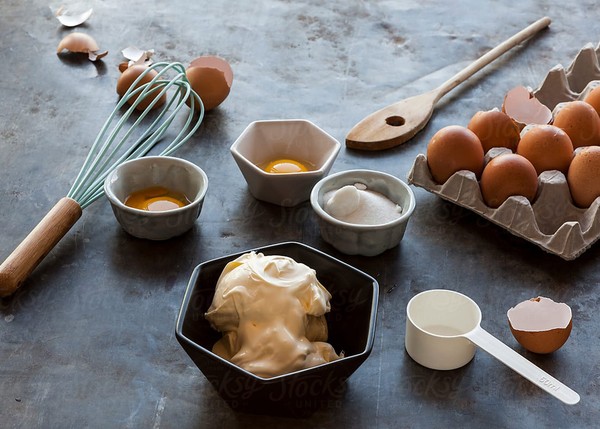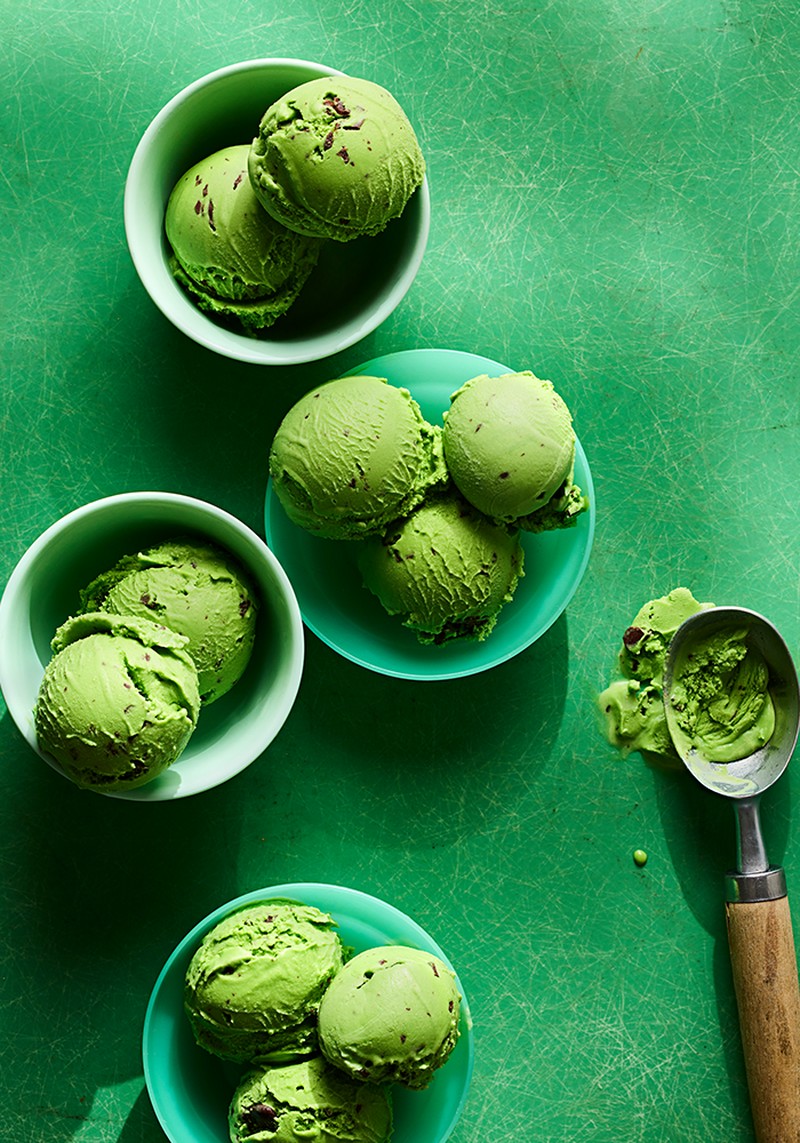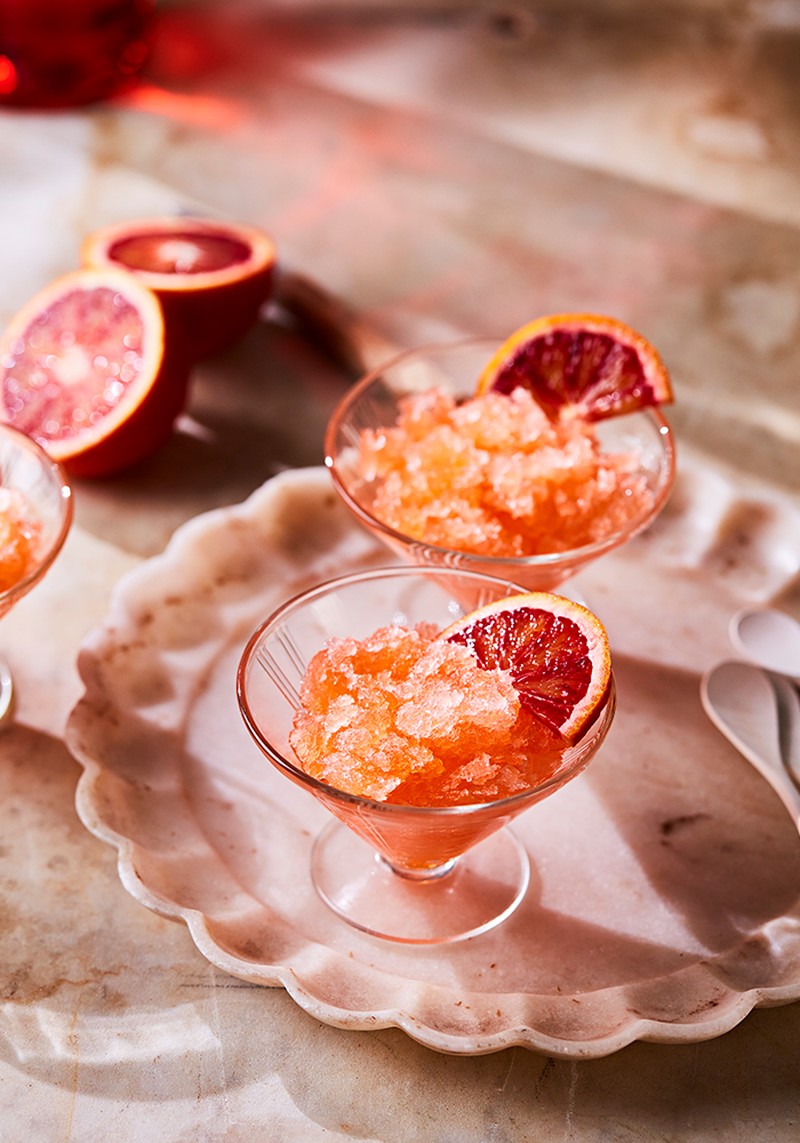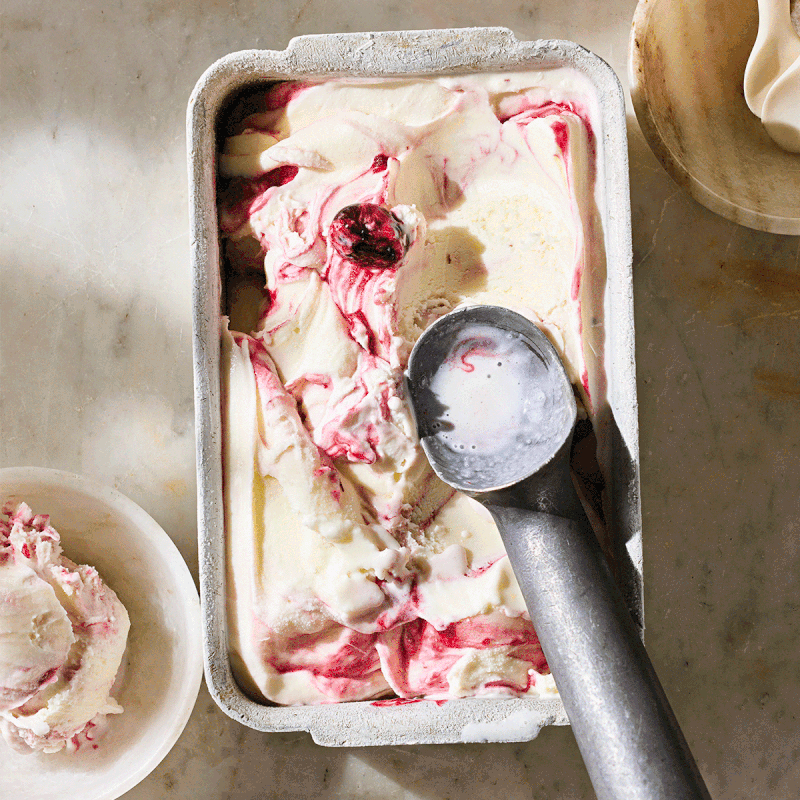How To Make Your Own Ice-Cream At Home
What are some of your first memories of eating gelato?
“My childhood was so closely entwined with gelato it’s hard to disentangle the memories,” says Jacob Kenedy, founder of Italian restaurant Bocca di Lupo and much-loved gelataria Gelupo. “I vividly remember being in London, though, specifically eating a raspberry and chocolate ice-cream at a little gelateria in Kensington and at Marine Ices, where I always had melon and mango. In Italy, I remember Little Bar in the upper town of Sperlonga, where I’d go for mint and chocolate orange, and Fiorelli in the lower town for wild strawberry and hazelnut gelato.”
What are some of the key ingredients?
“For gelato, it’s milk and sugar,” says Jacob. “That’s about all you need – for milky gelati there are some ingredients that have become synonymous with the autochthonous flavours of Italy – pistachio paste, hazelnut paste, and amarena (sour cherry ripple), but there are plenty of flavours (in fact, most of them) you can make without these. For good sorbet you need really good fruit.” If you’re opting for ice-cream, the traditional ingredients are sugar, milk, cream and flavourings, such as vanilla.
Can you make any substitutions?
Yes, says Sara Lewis, head chef at Vintry & Mercer. “You could use yogurt instead of milk and cream and use a flavouring with natural sweetness or something like a lower-percentage chocolate instead of adding any sugar,” she explains. “You can also use egg yolks to help with creaminess, but only if you’re using a recipe that contains egg – don’t just add them in as extras.”
Which milks work best?
Sara suggests full-fat milk, or condensed milk if you’re after a sweeter taste. Liam Dillon, head chef at The Boat Inn, explains: “I would use full-fat milk, but try to use whipping cream if you can. This reduces the amount of ice crystals in the ice-cream, which might form if you are not using a machine.” All of Jacob’s gelati use whole milk, plus skimmed milk powder. “Just the ones you get from the supermarket,” he explains. “The secret to great gelato is the formulation, and how you make it.”
What kitchen equipment do you need?
Thankfully, making ice-cream at home mostly involves using standard kitchen equipment: a mixing bowl, scales, sieve, whisk, a container to freeze the mix in and a saucepan if you’re making a classic egg-custard base. If you’ve got a temperature probe, this will also come in handy, says Liam.
Is an ice-cream maker necessary?
“You can easily make ice-cream at home without one,” says Sara. “However, the churner does help the mix become smoother while the freezing process begins.” Liam agrees: “I would always use a machine and I would be lost without ours in the restaurant. With ice-cream machines readily available, I’d say get one if you want to have a few goes at making your own. There are a range of machines that are basic or have built-in freezers.”
If you don’t have an ice-cream machine at home, Norma’s Ben Tish suggests making a semifreddo instead: “Whip up eggs yolks with sugar until the mixture goes pale and fluffy. Separately whisk the egg whites and some rich double cream. Grate in some bitter dark chocolate and combine everything together. Freeze in a tub for a few hours and you’ll have a delicious homemade dessert without the churning.”
Is the process the same for sorbets?
It’s actually a lot easier, says Liam. “It doesn’t need eggs, so you can literally throw everything in together. If you’re doing it without a machine, use a nice thick fruit puree for better results.” Meanwhile Sara suggests stirring the sorbet mix every few hours to ensure a creamy, even mix rather than an icy broken sorbet.

What is a stabiliser?
When water freezes it forms ice – crystals of frozen water that are crunchy. Stabiliser helps keep the ice crystals small as the gelato churns, and then helps prevent the resultant tiny ones joining together over time to become big ones if you store the gelato in the freezer. “You can omit the stabiliser and make decent gelato,” says Jacob. “But if you add a tiny bit, it makes the gelato a bit better when it’s fresh, and makes it keep much better if you store it overnight or longer. You just need a tiny bit, mind – you want the stabiliser to be imperceptible.” Egg proteins tend to be the most-used stabiliser in English and American ice-creams.
Are there any pitfalls to avoid?
“Don’t put big chunks of anything in the ice-cream as this breaks up the mixture when scooping,” warns Sara. “Break chunky things down to ensure you get a full smooth scoop.” Jacob’s advice is a little more light-hearted – making too little.
What are your favourite combinations?
“I love both mint chocolate chip or coffee and clotted cream,” says Sara. “And I like to serve it with a classic simple wafer and chopped nuts – that was always my chosen topping when the ice-cream van came to our street when I was a kid.” Jacob likes to combine classic flavours: “For me, it’s chocolate, coconut and raspberry; yoghurt and any fruit; hazelnut, coffee and any other creamy flavour; or strawberry and lemon.” And for Liam? “Lots of chocolate sprinkles will do the trick.”
What are your favourite toppings or serving suggestions?
To enjoy any one flavour of gelato to the max, serve it on its own, Jacob suggests: “Some flavours are nice served with fresh fruit or berries, and almost all can be served successfully with whipped cream (sweetened with 10% sugar – 10g per 100ml). I only ever make one sauce – a very dark chocolate one.”
Is it possible to make ice-creams healthier?
“I’m not sure there are any unhealthy foods – only unhealthy quantities,” says Jacob. “My advice? Use good ingredients and don’t ‘waste’ calories on food that isn’t amazing – if you’re going to eat anything, make sure it was worth it.”
Is homemade gelato healthier than shop-bought tubs?
“In terms of cost-to-benefit (i.e. calories-to-deliciousness), yes,” says Jacob. “Gelato tends to have a bit more sugar and a bit less fat than store-bought ice-creams (although my recipes are towards the low end of the sugar spectrum) – so if you’re avoiding fat then yes, if you’re avoiding sugar, no. But who eats desserts to be healthy? Eat desserts you love, in moderation and when you make a conscious decision to. Life is for living and enjoying – don’t punish yourself or ruin a delicious meal by ascribing guilt to it.”
Any final tips?
“Make sure to put your container in the freezer at least a few hours before using and always close with a tight-fitting lid or use cling film directly on top of the mix to avoid ice crystals forming on top,” says Sara. Liam goes one step further: “If you have time to allow your ice-cream mix to cool and mature in the fridge for 24 hours before you start to freeze it, you should. It helps with the end depth of flavour of the ice-cream.” Finally, Jacob has this piece of sage advice: “Don’t let ice-cream sit too long in the freezer. It’s better to make some and eat it within a few days, then make some more later on, than keep a tub in the freezer for ages.”
Inspired? Here are three of Jacob’s recipes to try at home…

Mint Stracciatella
There is a big difference between the taste of fresh mint leaves and the taste of toothpaste. You cannot, as far as I know, buy a really good mint ice-cream anywhere but in very few of the best ice-cream shops and gelaterie anywhere. The real deal is a breeze to make properly at home – all you need for a big mint flavour is a big bunch of mint. To keep it from browning in the gelato, the mint needs rapid blanching first, then rapid cooling to keep the flavour fresh. Before you start, ready yourself with a pan of unsalted boiling water and a bowl of iced water too. Stracciatella (meaning ‘raggedy’) is like a choc-chip, where molten chocolate is run through the gelato towards the end of its manufacture, creating fine chocolate shreds. You could omit the stracciatella for a plain mint gelato. But why would you?
To make the base bianca, stir the sugar, milk powder and stabiliser powder together thoroughly.
Put the milk and glucose or runny honey in a saucepan. Heat gently until barely simmering. Pour the contents of the bowl into the warm milk mixture in a steady stream, stirring as you go. Continue to stir until the mixture just returns to the boil, then remove from the heat. Cover the pan and leave the base to cool to room or fridge temperature. (It will keep for up to 5 days in the fridge if allowed to cool, then refrigerated immediately.)
To make the mint stracciatella gelato, have ready a large pan of boiling water and a bowl of iced water. Blanch the mint for literally 10 seconds in the boiling water (stalks and all), then drain and immediately refresh in the iced water. Drain the mint again and squeeze it dry.
Blend the mint finely with the cream, dextrose powder or icing sugar and the base bianca, until it looks like a green paint. Strain the mixture through a sieve into a bowl, pressing to get all the goodness out. (Discard the contents of the sieve.)
Transfer the verdant liquid to your ice-cream machine and churn until fully firm.
While the gelato is churning, gently melt together the chocolate and cocoa butter or coconut oil in a bowl set over a small pan of simmering water (or use a microwave on low). Allow the melted chocolate mixture to cool almost to room temperature.
When the gelato is as firm as you’d normally say it was ready, but certainly before it balls up on the paddle, pour in the chocolate in a steady stream with the ice-cream machine still running. The paddle will break the chocolate mixture into shards as it solidifies. A slower pour will yield finer strands; faster will be chunkier.
Before serving, put the mint stracciatella in the freezer for half an hour or so to firm up. If it has been stored in the freezer longer and is too firm, allow it to soften in the fridge until scoopable.

Ricotta & Sour Cherry
Sour cherries are fêted across mainland Europe for their concentrated flavour and lip-smacking zing. The classic amarena gelato is simple fior di latte (see page 30) variegated with sour cherry conserve. Outside of the gelateria, sour cherries are most often served with a custard, or with ricotta – famously in the Jewish bakery Boccione, in Rome’s ghetto, where they serve sour cherry and ricotta pie blackened and warm from the oven. In honour of this, I make my amarena with a ricotta base, and I like it better than plain sour cherry – it has a subtle cheesecake complexity and richness. This gelato has become Gelupo’s signature, if there is one.
First, make the ricotta base. In a small bowl, stir the sugar, milk powder and stabiliser powder together thoroughly. Put the milk and glucose or runny honey in a saucepan. Heat gently until barely simmering. Pour the contents of the bowl into the warm milk mixture in a steady stream, stirring as you go. Continue to stir until the mixture just returns to the boil, then remove from the heat.
Stir in the cream and leave the mixture to cool to about 50°C (just too hot to keep your fingertip in). Add the ricotta and almond extract (if using) and blend until smooth. Cover the base and leave to cool to room or fridge temperature. (It will keep for up to 5 days in the fridge if allowed to cool, then refrigerated immediately.)
To make the ricotta and sour cherry gelato, churn the ricotta base in your ice-cream machine until fully firm. Transfer the churned gelato to a freezer container and marble through the amarena variegato or sour cherry jam or compote to ripple.
Before serving, put the ricotta and sour cherry gelato in the freezer for half an hour or so to firm up. If it has been stored in the freezer longer and is too firm, allow it to soften in the fridge until scoopable.

Aperol Granita
Aperitivo time – and the omnipresent spritz – is the Veneto’s gift to the world. You can make a great spritz with Aperol (the lurid orange one) or Campari, or perhaps best with Select. And every spritz has its corresponding granita – just use the recipe below and substitute the aperitivo of your choosing.
In a bowl, stir all the ingredients together until the sugar has dissolved.
Transfer the mixture to a wide dish and put it in the freezer. Once it starts to freeze at the edges, every 10-15 minutes stir it with a fork or whisk it, until the mixture is almost completely frozen and icy (this will take a long time – perhaps 4 hours). It is ready to serve in this slightly wet, slushy state.
To keep it longer, let it freeze solid, then before serving take it out to thaw for 20 minutes or so, breaking it up with a fork. Chill your serving glasses for at least 20 minutes in the freezer before you serve.
Gelupo Gelato: A Delectable Palette of Ice-Cream Recipes by Jacob Kenedy is out now.
DISCLAIMER: We endeavour to always credit the correct original source of every image we use. If you think a credit may be incorrect, please contact us at info@sheerluxe.com.


